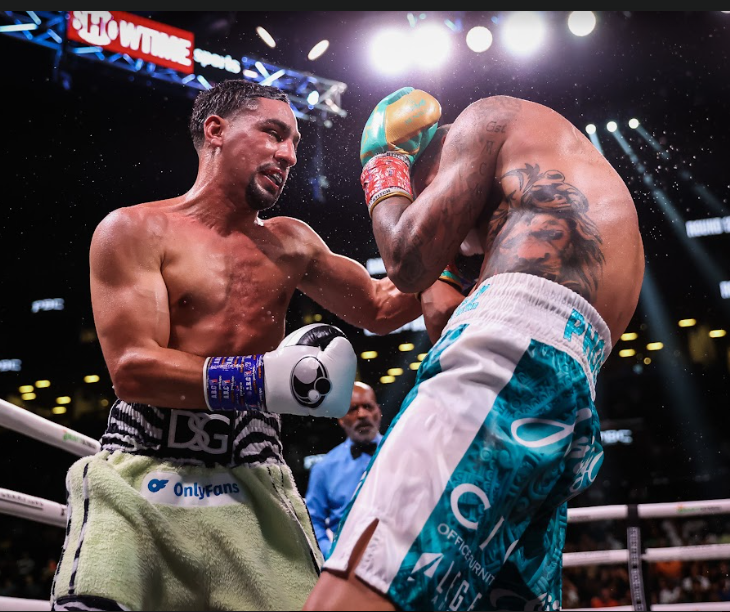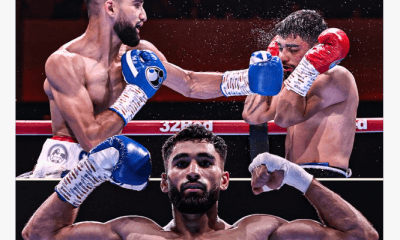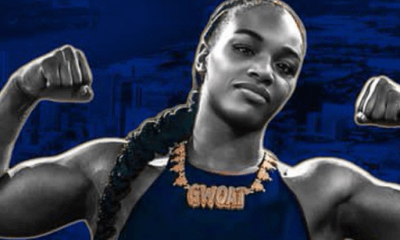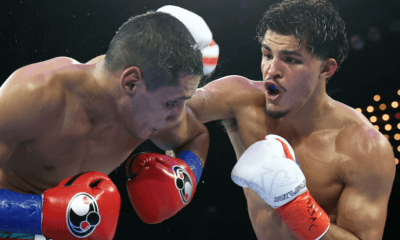Featured Articles
Danny Garcia Looked Very Sharp in Ring Return, Not That Everyone Noticed

After a career-long 19 months away from the ring, Danny “Swift” Garcia marked his victorious return in a new weight class with misty eyes that were not entirely shedding tears of joy. More like tears of relief, actually. The former super lightweight and welterweight world champion was discussing the reason why he had taken so much time off to reassess his life and the necessity to get his mind right in addition to whipping his body back into fighting shape.
“I was going through some mental things,” Garcia told SHOWTIME Championship Boxing interviewer Jim Gray after he had outpointed Jose Benavidez Jr. at Brooklyn’s Barclays Center in his super welterweight debut. “I felt a little dark. I went through some anxiety and depression. I was just trying my best to stay strong.
“It was just the pressure of life, the pressure of boxing. Of being a good dad. It weighed on me for a year and a half. I knew the only way to get better was to fight, and to win. I’m a fighter. That’s what I do and I love to do. If you battle anxiety and depression, get over it. That is what I did tonight. I came here and fought my heart out. I do have some dark days but I do my best to stay positive. But I felt good tonight.”
Well, the 34-year-old Garcia (37-3, 21 KOs) could be excused for shedding a tear of anguish when the first scorecard was read by ring announcer Jimmy Lennon Jr. after he had schooled Benavidez (27-2-1, 18 KOs) in so nearly flawless a performance that SHOWTIME’S unofficial scorer, Steve Farhood, had the Philadelphian winning 11 of 12 rounds, giving only the ninth to Benavidez. That 114-114 tally submitted by judge Waleska Roldan defied not only probability, but called into question the lady’s vision. Fortunately, the other two judges, Tony Paolillo and Glenn Feldman, ensured that a Brink’s Job-level robbery would not take place by favoring Garcia by margins of 117-111 and 116-112, respectively, although even those numbers were overly generous to Benavidez, the Phoenix fighter who had derided the eventual winner beforehand by claiming he was a one-trick pony, with no special quality other than a left hook which he could and would easily nullify.
Not one to easily give credit where credit was due, which would have been to acknowledge the superiority of the other guy on this particular night, Benavidez told Gray that “I’m happy with my performance. I feel like I did a good job. I took his punches like they were nothing. I honestly thought I won, but it is what it is. I’m not going to let this bring me down. A loss just makes you stronger.”
Asked if he would fight again, Benavidez – whose father-trainer, Jose Benavidez Sr., had said earlier in the day that “My son has to win tonight, or his career is basically over” – the younger man said, “Hell, yeah, I’d like to continue. I want a rematch.”
If it happens, which it almost certainly won’t, it’s reasonable to assume that Roldan won’t be seated at ringside with a pencil and score pad if the bout is held in the Big Apple or anywhere else in the Empire State. In this era of female empowerment, this latest head-scratcher from the New York City resident brought memories of another woman judge, C.J. Ross, whose qualifications for working major bouts was so called into question that she submitted her resignation from the Nevada State Athletic Commission – possibly not of her own volition — to then-executive director Keith Kizer shortly after she saw the Floyd Mayweather Jr.-Canelo Alvarez bout in September 2013 as a 114-114 standoff. The other two judges had Mayweather, who appeared to win as handily as did Garcia against Benavidez, winning by margins of 117-111 and 116-112, making the Barclays bout nearly nine years later as a virtual repeat.
A bad night, if it is rare enough, can be excused, but not if it seemingly is part of a pattern. Ross had raised eyebrows by being one of two judges who had Timothy Bradley Jr. dethroning WBO welterweight titlist Manny Pacquiao on a 12-round split decision on June 9, 2012, but that was a bit closer than Garcia-Benavidez was, although a majority of ringside reporters and other knowledgeable observers felt Pacquiao had done enough to get the victory. Roldan’s companion piece to that curious call was her 117-111 card favoring Jeff Horn in his WBO welterweight title-wresting unanimous decision over Pacquiao in Horn’s home country of Australia, another instance where many media types covering the event believed “PacMan” to have won at least semi-convincingly.
Roldan declined to comment on her rationale for scoring Saturday night’s fight as she did, and the New York State Athletic Commission also was mum, ostensibly until it has the opportunity to speak to Roldan. It will be interesting to learn if NYSAC executive director Kim Sumbler is amenable to whatever Roldan has to say and gives her more judging assignments. But justifying that scorecard might require the verbal dexterity of the late F. Lee Bailey.
“How Waleska Roldan got the score she got, I have no idea,” Farhood opined. “She had Benavidez ahead after 11 rounds. She scored it even only because she gave Garcia the 12th. I saw a totally different fight. I saw total domination by Danny Garcia.”
Punch statistics, never an indisputable method of determining who should or should not deserve to win a fight, would appear to support the notion of Garcia deserving better than a majority decision. Although he out-landed in total punches, 233 of 746 (32.1 percent) to 117 of 600 (19.5 percent), the gap in body shots was Grand Canyonesque. Garcia connected on 153 body blows to just 12 for Benavidez.
But Roldan’s scorecard wasn’t the only mess the NYSAC might have to sweep under the rug. In the first of the three PBC on SHOWTIME televised bouts, referee Shada Murdagh waved off further action 50 seconds into the sixth round of the scheduled 10-rounder between super lightweights Gary Antuanne Russell (16-0, 16 KOs) and former two-division world champ Rances Barthelemy (29-2-1, 15 KOs) after Russell, a southpaw, registered a knockdown with a ripping right hook. Barthelemy beat the count and did not appear to be unduly damaged, but Murdagh showed he had a quicker trigger finger than Wild Bill Hickock.
“No, no, they shouldn’t have stopped the fight,” Barthelemy complained. “This is not the first time I’ve fallen and gotten up. I felt good. It was a good shot, I’m not denying that, but they shouldn’t have stopped the fight.”
Russell, fighting for the first time without his late father Gary Russell Sr. as his chief second, figured the ending was preordained regardless of whether Murdagh was hasty in making the call that he did.
“If they would have let the fight continue, I’m pretty sure later on down the road, the same outcome would have been it,” he said.
The middle bout paired 513 pounds of fleshy heavyweights, Poland-born, Brooklyn-based Adam Kownacki (20-3, 15 KOs) and Turkish national Ali Eren Demirezen (17-1, 12 KOs). Kownacki, fighting at Barclays Center for the 11th time, started fast, winning the first two rounds, but he faded thereafter in losing a 10-round unanimous decision. It was the third straight loss for Brooklyn favorite Kownacki, who hinted at retirement, if not immediately, then soon.
“I have two kids,” he said. “I’ll have a long talk with my wife to see what I want to do. I’ve had so many fights here, so many great memories. I don’t want to go out like a loser. I would like another fight to leave my fans with a win.”
Back to the main event. Roldan’s dubious arithmetic did not and should not overshadow the excellent work done by Garcia, who claimed to feel comfortable at a career-high 152¾ pounds, but it will take more than one good win at super welter to validate him as a legitimate player in his new division, even if the WBC did list him as its No. 5 contender without his fighting even once at the heavier weight. Former IBF super welterweight champ Tony Harrison was in the house – as were Philly fighters Jaron “Boots” Ennis and Stephen Fulton Jr., supporting their hometown buddy — and he said he’d like to be the next man up for Garcia.
“It’s a logical next fight,” SHOWTIME analyst Al Bernstein said of the idea of a Garcia-Harrison pairing. “What Danny Garcia showed tonight is that technically he’s a proficient fighter, he still is a good fighter. What he would like to show now is that he can beat a proper 154-pounder – and maybe he can. Tony Harrison would be a perfect example of a really good 154-pounder for him to face.”
That is a roundabout way of saying that maybe Benavidez, 30, wasn’t, even though his record and his lineage (he has two other brothers who are quite accomplished pros) suggest otherwise. But Benavidez had his own comeback story to tell in the lead-up to the fight, and it was equal to or even more interesting than Garcia’s. He was shot in his right leg in August 2016 while walking his cat, of all things, and for a time it appeared he might never fight again. He was inactive for three years, gorging his way past 210 pounds and spending his afternoons watching soap operas as a couch potato eating, well, potato chips. He had to pare 70 pounds in order to procure his most recent bout prior to Garcia, in which he had to settle for a 10-round majority draw with Francisco Torres on Nov. 13, 2021.
All three SHOWTIME fights were worthy of viewer attention from a strictly boxing standpoint. It’s unfortunate that a referee and a judge siphoned off some of the spotlight by insinuating themselves, intentionally or not, into the narrative.
Photo credit: Amanda Westcott / SHOWTIME
Bernard Fernandez, named to the International Boxing Hall of Fame in the Observer category with the Class of 2020, was the recipient of numerous awards for writing excellence during his 28-year career as a sports writer for the Philadelphia Daily News. Fernandez’s first book, “Championship Rounds,” a compendium of previously published material, was released in May of last year. The sequel, “Championship Rounds, Round 2,” with a foreword by Jim Lampley, is currently out. The anthology can be ordered through Amazon.com and other book-selling websites and outlets.
To comment on this story in the Fight Forum CLICK HERE
-

 Featured Articles3 weeks ago
Featured Articles3 weeks agoResults and Recaps from New York Where Taylor Edged Serrano Once Again
-

 Featured Articles5 days ago
Featured Articles5 days agoThe Hauser Report: Zayas-Garcia, Pacquiao, Usyk, and the NYSAC
-

 Featured Articles3 weeks ago
Featured Articles3 weeks agoResults and Recaps from NYC where Hamzah Sheeraz was Spectacular
-

 Featured Articles4 weeks ago
Featured Articles4 weeks agoFrom a Sympathetic Figure to a Pariah: The Travails of Julio Cesar Chavez Jr
-

 Featured Articles2 weeks ago
Featured Articles2 weeks agoManny Pacquiao and Mario Barrios Fight to a Draw; Fundora stops Tim Tszyu
-

 Featured Articles3 weeks ago
Featured Articles3 weeks agoPhiladelphia Welterweight Gil Turner, a Phenom, Now Rests in an Unmarked Grave
-

 Featured Articles2 weeks ago
Featured Articles2 weeks agoArne’s Almanac: Pacquiao-Barrios Redux
-

 Featured Articles4 weeks ago
Featured Articles4 weeks agoCatterall vs Eubank Ends Prematurely; Catterall Wins a Technical Decision






















